Small mushrooms, often overlooked and underestimated, possess a captivating charm that belies their diminutive size.
These tiny fungi, scattered across forests, fields, and even urban environments, have long intrigued scientists and foragers alike. From their intricate forms to their remarkable ability to thrive in diverse habitats, small mushrooms offer a world of hidden wonders waiting to be explored.
In this article, we delve into the fascinating realm of these minuscule marvels, unraveling their significance in ecosystems and uncovering the secrets they hold within their delicate structures.
Join us on this journey as we shed light on the enchanting world of small fungi and discover why size is no measure of importance in nature’s grand tapestry.
List of Small Mushrooms
1. Deadly Galerina
The deadly galerina is a small mushroom from the family Hymenogastraceae. Despite its petite size, this fungus is considered one of the most dangerous mushrooms in the world.
Its scientific name, galerina marginata, reflects its marginate cap edges, which distinguish it from other similar species.
What makes the deadly galerina so perilous is its production of amatoxins, a group of highly toxic compounds found in several mushroom species.
Unfortunately, due to its small size and appearance resembling harmless little brown mushrooms, many people mistake deadly gallerinas for edible varieties. Therefore, it is crucial for mushroom enthusiasts to be able to identify it accurately.
2. Conocybe Apala (Milky Conecap)
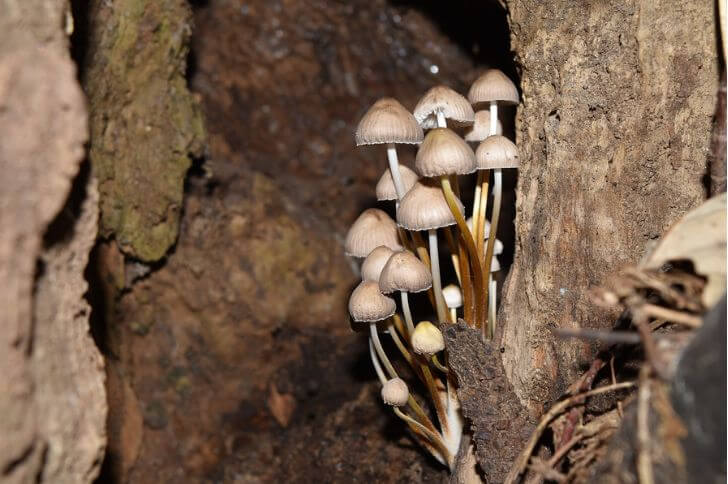
Conocybe apala is a species of small mushroom commonly found in grassy areas and lawns. These mushrooms typically have a cap that ranges from 0.5 inches in diameter, with a conical shape when young and expanding to convex or bell-shaped as they mature. The color of the cap can vary, but it is often pale or light tan.
The stem of this tiny mushroom is slender and fragile, measuring around 2.75-4 inches in length. It has a whitish or pale yellow coloration which may darken towards the base.
The gills underneath the cap are closely spaced and initially white before darkening to brown as the spores mature.
3. Wood Ear mushrooms
Wood ear mushrooms are a type of edible fungus that are commonly found growing on dead or decaying wood, particularly on tree trunks.
These small mushrooms have a distinctive appearance, with dark brown to black caps that are shaped like an ear or a cup. They have a rubbery texture.
Despite their unassuming size, wood ear mushrooms pack quite the nutritional punch. They are low in calories and fat but rich in dietary fiber, iron, and essential vitamins like vitamin B2 and vitamin D.
This makes them a great addition to various dishes for those looking for a healthy alternative.
In culinary applications, wood ear mushrooms are highly versatile due to their mild flavor and unique texture.
They can be used fresh or dried and rehydrated before cooking. In Chinese cuisine, they are often added to soups, stir-fries, hot pots, and even vegetarian dishes as they absorb flavors well while retaining their chewiness.
Their gelatinous nature also makes them popular in salads or cold appetizers where they add both visual appeal and textural contrast.
4. Enoki mushrooms
Enoki mushrooms are small and delicate fungi that belong to the family Physalacriaceae. These mushrooms have a unique appearance with long, thin stems and tiny caps that resemble clusters of white needles.
Despite their petite size, enoki mushrooms offer a delightful crunch and a mild, slightly sweet taste. They are commonly cultivated in Asia but have gained popularity worldwide due to their versatility in various cuisines.
Enoki mushrooms are highly regarded for their nutritional value as they contain essential vitamins and minerals.
Furthermore, enoki mushrooms are a great source of dietary fiber. When it comes to culinary uses, enoki mushrooms add an interesting texture and flavor to dishes. Due to their delicate nature, they are often enjoyed raw or lightly cooked to preserve their crunchy texture
. Enokis can be used in salads or added as a garnish on top of soups for an elegant touch. They also pair well with stir-fries as they absorb flavors easily while retaining their unique crispness.
5. Tubaria Furfuracea (scurfy twiglet)
Tubaria furfuracea or the scurfy twiglet is another small brown mushroom that can be found in various habitats such as woodlands, grasslands, and gardens.
This mushroom typically has a cap diameter ranging from 0.5-1.5 inches, with a convex shape that eventually becomes flattened. The color of the cap can vary from pale brown to orange-brown, with noticeable margins.
The gills are closely spaced and are rusty brown. The stem is usually thin and fragile, often measuring around 1-1.9 inches tall.
Scurfy twiglets are inedible.
6. Agaricus sylvicola (Wood Mushroom)
Agaricus sylvicola, colloquially called the wood mushroom, are a species of mushroom that are typically characterized by their small size and delicate appearance. They have a pale cream convex cap that can grow up to 6 inches in diameter.
The cap turns yellowish when bruised. Another distinguishing feature of this small-sized mushroom is its stem, which is slender and often has a slight taper towards the base.
The stem is typically white or cream-colored and can reach heights of up to 6 inches. Another notable characteristic of these mushrooms is their gills, which are initially white but darken to a chocolate brown or pinkish-gray as the mushroom matures.
Is this wood mushroom edible? Yes. However, because it closely resembles the death cap mushroom we recommend avoiding it altogether and only pick it if you can tell it apart from other look-alikes.
7. Parrot Toadstool
One fascinating type of small mushroom is the parrot toadstool. With its vibrant colors and unique shape, this mushroom stands out in any forest or woodland setting.
In terms of coloration, the parrot toadstool exhibits striking hues of green or blue during its early days which then turns to yellow or greenish yellow with age and sometimes may have purplish tinge.
Found primarily in damp environments such as forests or near decaying wood, this mushroom thrives in areas abundant with organic matter. Its small size allows it to grow amidst leaf litter or grass without being easily noticed by passersby.
Parrot toadstools are edible. However, they are too small and very slimy, making them unpalatable.
8. Entoloma Hochstetteri (Blue pinkgill)
Entoloma hochstetteri, a species of small mushroom found in New Zealand, is undoubtedly a captivating subject for mycologists. These intriguing fungi are characterized by their vibrant blue coloration and delicate appearance.
Growing mainly in beech forests, blue pinkgills can reach heights of up to 5 inches.
Despite their diminutive size, these mushrooms are important decomposers.
9. Phallus Indusiatus (Veiled Mushroom)
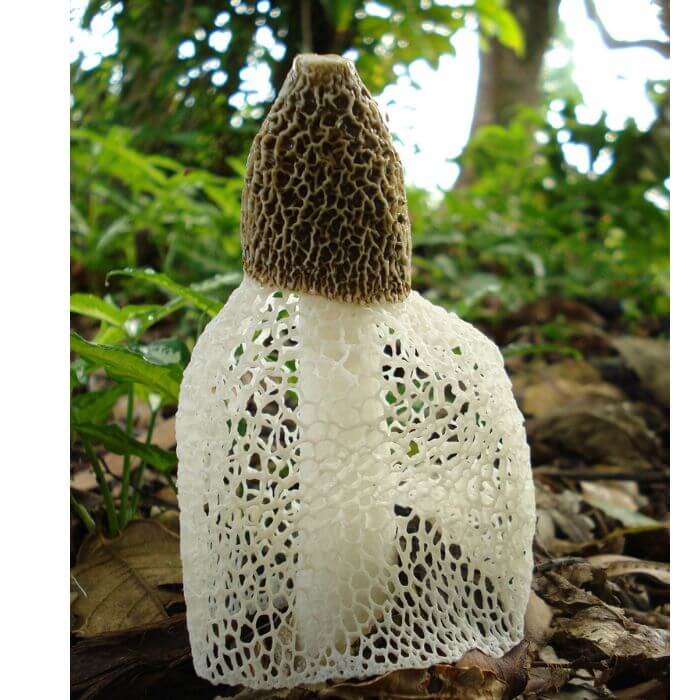
Phallus indusiatus, commonly known as the veiled lady or long net stinkhorn, is a small mushroom belonging to the family phallaceae. These mushrooms are characterized by their slender and elongated shape, reaching up to 10 inches in height.
The fruiting bodies of veiled mushrooms emerge from the ground, covered with a delicate white veil-like structure called an indusium.
The remarkable feature of this mushroom lies in its reproductive strategy. As it matures, the indusium gradually tears apart to expose the spore-bearing structure beneath.
This inner portion is shaped like a bell or trumpet and is coated with a layer of dark olive-green slime that emits a pungent odor—resembling rotting flesh—to attract insects for pollination.
Flies are particularly attracted to this stench and play a vital role in dispersing the spores of Phallus indusiatus as they land on the slimy surface.
Due to their unique appearance and intriguing reproductive behavior, these small mushrooms have captured the interest of both amateur mushroom enthusiasts and researchers alike.
These mushrooms can be found growing on forest floors or in gardens across various regions worldwide, predominantly in tropical areas but also within subtropical and temperate climates.
While they may not be widely consumed due to their strong odor, some cultures appreciate them for their culinary value.
10. Marasmius Rotula (Pinwheel mushroom)
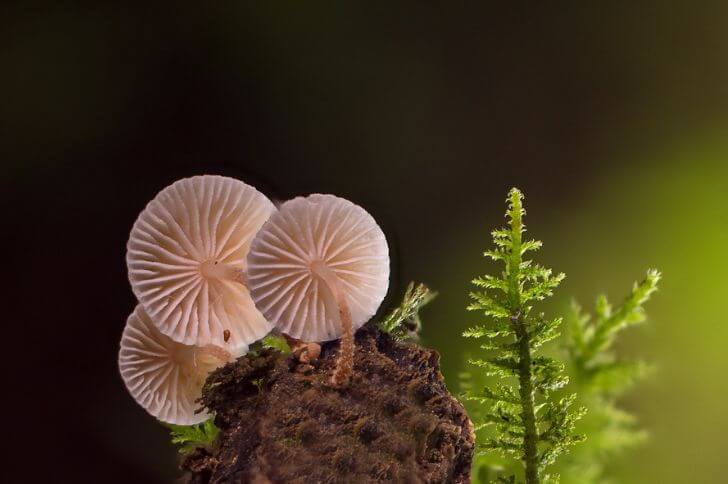
Marasmius rotula, commonly known as the pinwheel mushroom, belongs to the family Marasmiaceae. These small mushrooms are typically found growing in clusters on decaying logs, leaf litter, or forest floors.
Marasmius rotula is characterized by its distinctive cap, which ranges from 1-2 inches in diameter and has a convex shape when young but becomes flat with age.
The cap of Marasmius rotula is usually pinkish-white in color. The gills underneath the cap are widely spaced and white in color.
Another notable feature of this mushroom is its long, thin stem that can reach up to 3.1 inches in height. The stem is typically white or light brown and often bends slightly at the base.
This small mushroom is an edible mushroom but it is not highly sought after for culinary purposes due to its small size and relatively bitter taste.
11. Panaeolus Foenisecii (Mower’s Mushroom)
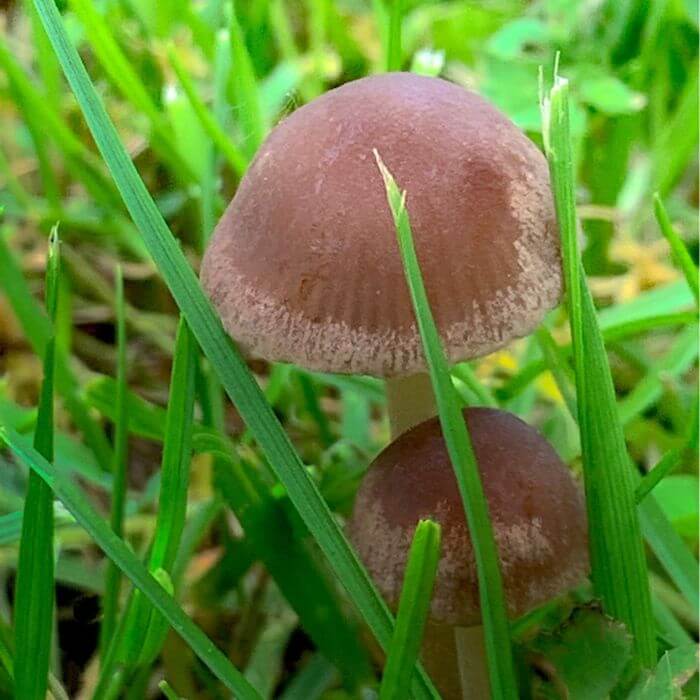
Panaeolus foenisecii or the mower’s mushroom or the haymaker’s mushroom, is a species of small mushrooms that can be found in various grassy areas such as lawns, meadows, and pastures.
These mushrooms typically grow in clusters and have a slender stem that can reach up to 3.1 inches in height. The cap of mower’s mushroom is usually brownish or greyish in color and can measure around 1.2 inches in diameter.
Despite its small size, mower’s mushroom holds some significance within the mycological community. Although considered non-toxic, this species closely resembles another mushroom called psilocybe cubensis, which is inedible.
Therefore, it is crucial for individuals interested in wild mushroom hunting to familiarize themselves with distinguishing features between these two species.
While this small mushroom does not possess any remarkable culinary or medicinal value, its presence serves as a reminder of the diverse and fascinating world of fungi that exists all around us.
12. Bolbitius Titubans (Yellow Fieldcap)
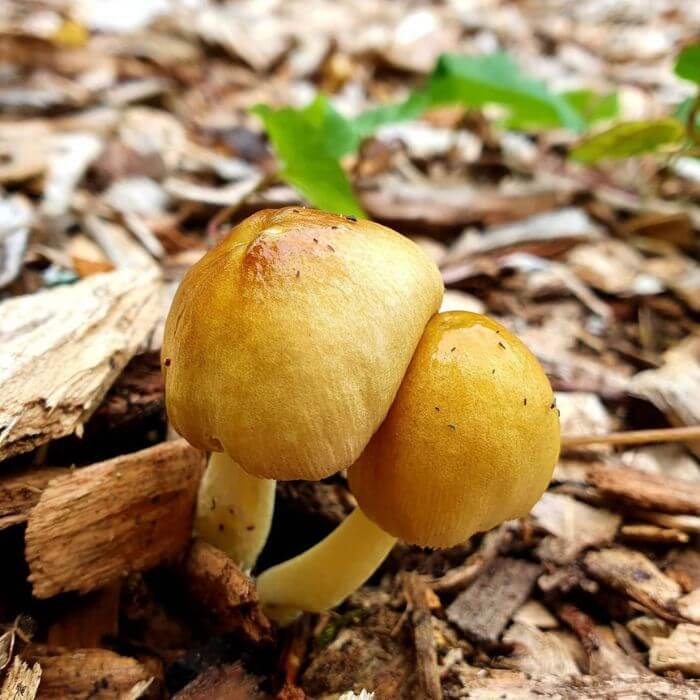
source:tinygramat
A member of the bolbitiaceae family, the bolbitius titubans or yellow fieldcap is a small mushroom characterized by a vibrant yellow coloring and delicate appearance.
They typically have convex caps. The cap color may vary depending on the age of the mushroom; younger specimens tend to have bright yellow caps that often fade into paler shades as they mature.
Another feature of yellow fieldcap is their gills, which start out pale yellow and gradually turn cinnamon brown as they mature.
This color change is caused by the spores produced by the mushroom, which are released from the gills when ready for dispersal. Another notable characteristic of these mushrooms is their fragile structure. The stems are slender and hollow, making them susceptible to damage from wind or rain.
Due to their small size and delicate nature, these tiny mushrooms are often found growing in clusters or scattered across grassy areas such as lawns or fields during damp weather conditions.
These mushrooms thrive in nutrient-rich soil and are commonly encountered from late summer through fall.
13. Cantharellus minor
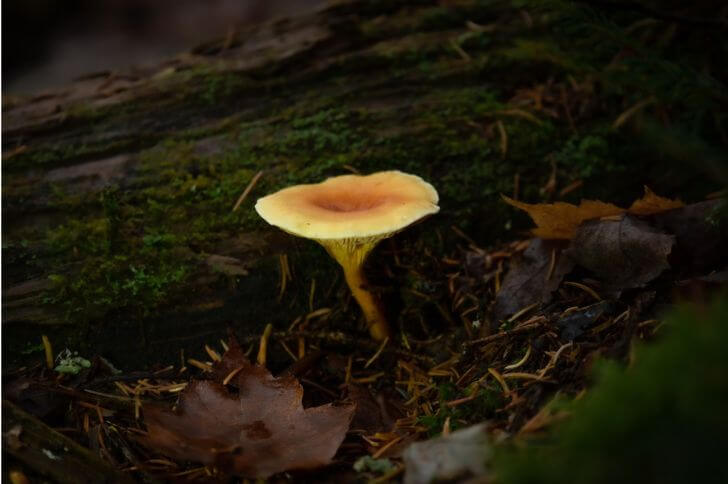
Cantharellus minor, commonly known as the lesser chanterelle or small chanterelle, is a species of wild edible mushroom that can be found in various regions around the world.
One distinctive characteristic of Cantharellus minor is its relatively small size compared to other members of the same genus. The cap diameter typically ranges from 0.5-0.7 inches making it easily distinguishable from larger chanterelles.
Despite its smaller size, Cantharellus minor possesses a strong and appealing flavor that is often described as nutty and earthy.
This unique taste makes it a popular choice among mushroom enthusiasts who enjoy foraging for their own food. In addition to its culinary value, the small size of Cantharellus minor also plays a role in its ecological importance.
The mushroom’s diminutive stature allows it to thrive in diverse habitats, including forests, woodlands, and even grassy areas.
While Cantharellus minor may not be as well-known as some of its larger counterparts, such as Cantharellus cibarius (commonly known as the golden chanterelle), it still holds an important place in both natural ecosystems and gourmet dishes alike.
Its compact size makes it easier to spot during foraging expeditions and adds a delightful texture to various recipes when cooked properly.
14. Mycena Crocea (Walnut mycena)
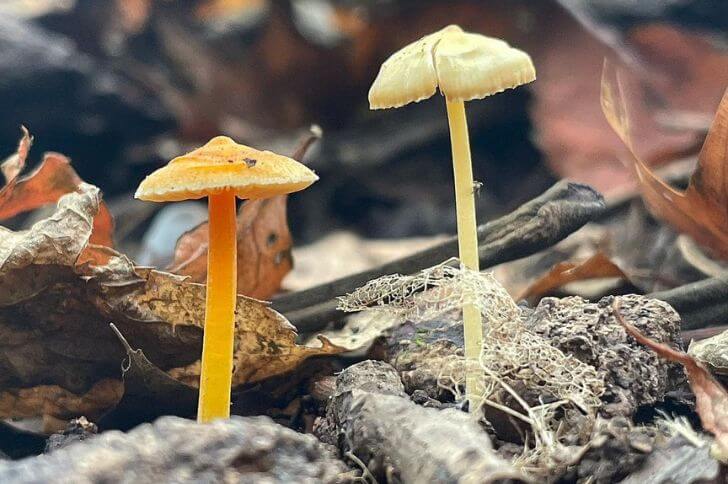
source:deadphoneplease
Mycena crocea are tiny fungi that grow in clusters on decaying wood, leaf litter, or mossy areas in forests and grasslands. Also called walnut mycena, these tiny mushrooms have convex or flat caps with vibrant saffron-yellow colors that can fade to pale yellow with age.
Like most mushrooms on this list, they have a long slender stem that ranges from light yellow to white. The gills underneath the cap are well spaced and the same color as the cap.
These mushrooms have a delicate texture and emit no discernible odor. While not widely cultivated for consumption due to their diminutive size, some mycophiles do appreciate these tiny mushrooms for their aesthetic value and uniqueness.
15. Schizophyllum Commune (Split Gill)
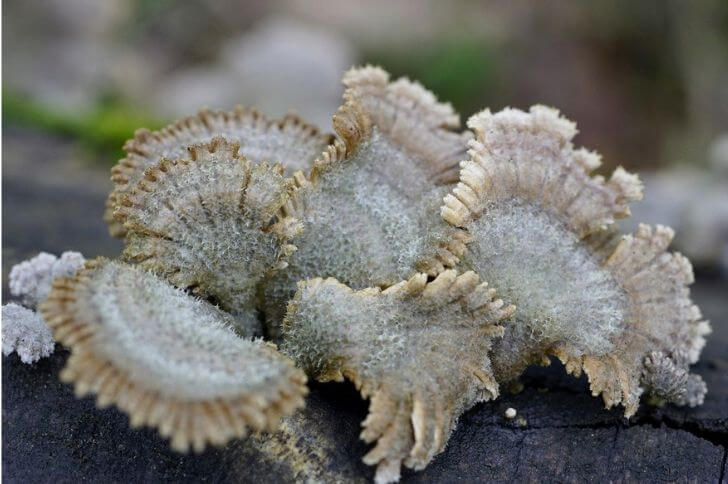
Split gills are from the family Schizophyllaceae. Scientifically called schizophyllum commune, these small mushrooms are widely distributed across the globe and can be found growing on decaying wood or tree stumps.
The name split gill comes from the distinctive appearance of their gills, which have a unique split or forked structure.
Although not particularly large or visually striking compared to other mushroom species, the split gill mushroom plays an important ecological role.
Also, note these mushrooms are inedible due to their tough fruiting body and small size.
Final Thoughts:
Small mushrooms may be overlooked in the world of fungi, but their importance should not be underestimated. These tiny fungi play a vital role in maintaining healthy ecosystems and provide numerous benefits to humans.
From their ability to decompose organic matter and recycle nutrients to their culinary value, mushrooms with small fruiting bodies have much to offer. By recognizing and appreciating the value of these often overlooked organisms, we can better understand and protect the delicate balance of our natural world.
So next time you come across a small mushroom on your nature hike, take a moment to appreciate its significance and marvel at the wonders of nature’s smallest inhabitants.
Hi There,
My name is Jenny. I’m the Chief Editor at Try Green Recipes and besides making yummy and healthy foods for my kids, grandkids, and friends. I’m new to the blogging world but I believe what I have to share is unique and will bring joy to your home. If you are adventurous and want try something tasty, let’s get started.

